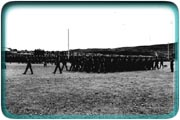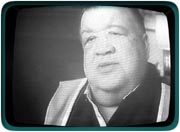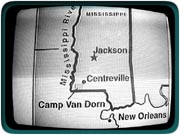May 1724, 2001
cover story
The Mysterious 364th
Were members of a Mississippi-based black regiment, including soldiers from Philadelphia, gunned down in 1943 to silence their demands for equality? And were their killers fellow soldiers?
 |
|
|
The army vanishes: The 364th regiment at Camp Van Dorn. After June 1943, one soldiers name per day disappeared from the roster. photo: Edward Boll |
|
part 1 | part 2
In March 1942, the 367th black combat unit in the segregated U.S. Army was re-named the 364th (Negro) Infantry Regiment. It took in a batch of new recruits mostly from Northern cities like Philadelphia, New York and Chicago and the regiment of about 3,000 men was ordered south to Arizona in June. By fall, the full regiment was bivouacked at Papago Park in Phoenix.
Letters from soldiers there and elsewhere the unit was stationed including missives to the Philadelphia Tribune complained about their plight at the desolate base. Army investigators later described a situation in which black enlisted men suffered myriad hardships and indignities far beyond the tough life of your average GI in boot camp.
Some marched in nearly soleless shoes through the rugged Superstition Mountains in desert heat. At any given time, 65 to 85 men were imprisoned in a primitive outdoor stockade, often for minor infractions. In a situation in which white officers oversaw segregated units of black enlisted men, the 364ths commanding officer was known to draw his pistol and shoot at the feet of soldiers to get them to “look lively.”
These incidents would only be harbingers of racial violence to come.
During WWII, there were hundreds of bloody, racially charged domestic firefights at bases and their surrounding communities throughout the country, all involving black soldiers, sometimes under attack by MPs, sometimes by white civilians. The skirmishes received press coverage depending on the accessibility of the base. The official record lists one dead, two wounded during a night of fighting in 1942 at Ft. Dix,
New Jersey;
one dead, five wounded at Camp Shenango, Pennsylvania, on July 14, 1943, for example.
The U.S. Army was doing everything it could to downplay publicly the widespread racial violence in 1943. But military intelligence was concerned that the situation could worsen. Intelligence operatives were reading the personal letters of black and white soldiers and using the information in a sociological model to gauge where racial unrest could explode. A declassified executive summary of this work for the Third Service Command (essentially the mid-Atlantic states) concluded the following: “Negro riots which could either seriously hamper war production or pass beyond the control of civil authorities, and thus require Federal Troops, might take place at any of the following cities in estimated order of probability: Baltimore, Md.; Chester, Pa.; Harrisburg, Pa.”
The ongoing controversy will be examined in an upcoming History Channel documentary, The Mystery of the 364th, scheduled to premiere on May 20. The hour-long program explores allegations that, upon first read, seem ridiculous especially a charge that 1,200 African-American combat troops were killed by white soldiers in a single massacre at Camp Van Dorn in the isolated town of
Centreville, MS, and that a subsequent cover-up has gone on for almost 60 years. That claim was made in a 1998 book, The Slaughter: An American Atrocity. Former Mississippi banker Carroll Case pursued the claim for years after one of his employees told Case he had participated in the killing. William “Bill” Martzall, who joined the military police of the 63rd Division out of his home in Dillsburg, PA, first told Case this tale in the 1980s. Martzall has since died. The U.S. Army categorically denies Martzalls version and claims he could not have even been in Camp Van Dorn during the period he described to Case.
The military in World War II was not “Colin Powells Army,” as some call the integrated armed forces that saw the rise of a black man to high rank and national prominence. The mystery of the 364th and the racial crisis of which it is emblematic needs to be examined in light of the prejudices of the day.
The military was completely segregated, thoroughly “Jim Crow.” The Marines did not accept blacks at all. The Navy accepted them only for menial jobs. The Army reluctantly bowed to pressure and inducted some blacks into segregated units led by a white officer corps. Most black regiments were service units. Those few designated for combat were typically under-trained, under-supplied and sent to dreadful stations where they were isolated and subject to insult and attack from hostile, white civilians.
This prejudiced conduct was justified by Army War College studies like the so-called “Bly report,” issued in 1925, in response to racial problems in World War I. In among pseudo-scientific claptrap on the smaller “cranial cavities” of Negroes is this sweeping assertion: “The Negro does not perform his share of civil duties in time of peace. He has no leaders in industrial or commercial life. He takes no part in government. Compared to the white man he is admittedly of inferior mentality. He is inherently weak in character.”
With this as a blueprint, it is no surprise that despite the threat of a new world war, the military establishment resisted black participation. Some cities experienced riots when blacks were turned away from induction centers.
 |
|
|
He wasnt there: The 364ths regimental journal was signed by Malcolm LaPlace, but he wasnt in the service in 1942. |
|
Though historians argue over Franklin Roosevelts political motives, the president appears in his declassified papers as adamant about a 10 percent quota for blacks in the Army as he was about his threat to withhold defense contracts from companies discriminating against blacks. White workers in shipyards from Mobile, AL, to Chester, PA, rioted against the presidents directives. In 1943 in Detroit, at about the same time the first race riots were reported at Camp Van Dorn, white workers enraged by black participation in the burgeoning war industry rioted for three days.
The final toll: 25 blacks and nine whites were killed, hundreds injured, millions of dollars in damage.
 |
|
Black soldiers in Phoenix with the 364th began to protest conditions in the fall of 1942. One soldier, writing a “John Doe” letter to U.S. Sen. Joseph Guffey (D-PA), reported what was going on.
“One young man, Francis Johnson of Chester, PA, has been out on bread and water for fifteen days because he resented the Commanding Officers kicking him,” the letter said. “This young man has gone on a hunger strike, hoping that his death will focus the attention of the War Department on the rotten conditions of this regiment.”
There is no evidence that Pvt. Johnson died from his hunger strike, but his days with the 364th must have been numbered. A 1999 Army report on the regiment covering April through December 1943 does not list a Pvt. Francis Johnson.
The anonymous letter writer warned that things could only get worse with the 364th. “Every day situations arise which have now come to a state of explosion. If there is no change here, all of us from Pennsylvania have decided to go AWOL rather than be murdered in uniforms of the United States Army. We can appeal to nobody but our two Senators. Your delay, sir, may be the cause of a disgraceful consequence.”
A representative of the Army Inspector Generals Office was already in Phoenix investigating the conditions of the 364th provoked by a letter from one of the units chaplains when Guffey forwarded the “John Doe” letter to Army Chief of Staff George C. Marshall
for “such action as in your judgment may be warranted.” Marshall dispatched a second investigator to respond to the additional complaints.
One month after the investigations were complete, some members of the 364th rioted in nearby downtown Phoenix. The details and body count of the “Phoenix Massacre” continue to be argued. In yet another aspect of a soon-to-be-repeated pattern, an initial altercation escalated when the soldiers returned to camp, armed themselves and returned to Phoenix. All that is known for sure is that the firefight lasted all night over the predominantly black section of that desert town. Soldiers, police and civilians were killed and wounded in a battle that resulted in at least 14 casualties, including three deaths. Nineteen members of the 364th were court-martialed for their roles in the disturbance. Most received 50-year prison terms; one was sentenced to death. (President Franklin Roosevelt later reduced the prison terms and vacated the death sentence.)
The Arizona Congressional delegation urged the 364th be sent packing. The army agreed. But where? Studies at the wars onset warned that domestic racial problems posed a threat to troop mobilization and arms production and could lead to propaganda disasters. Agents for the Japanese, for example, were already promising Southern blacks their “brothers in color” freedom from white oppression, even economic rewards. Each report of racial violence that leaked out made its way to German and Japanese broadcasts to American soldiers overseas. A mid-war intelligence-led opinion survey suggested that 10 percent of the black population thought they would be better off under Japanese rule. One study was adamant in its findings about the deployment of black troops: “
as little movement as possible be made into areas where racial relations are different from their home environment,” concluded “The Negro Problem in the Army,” circulated by Maj. Gen. Geo. Strong
June 17, 1942.
This advice was not heeded when the most rebellious black combat unit the U.S. had ever seen was sent to the nations epicenter of racial hate and violence.
part 1 | part 2
